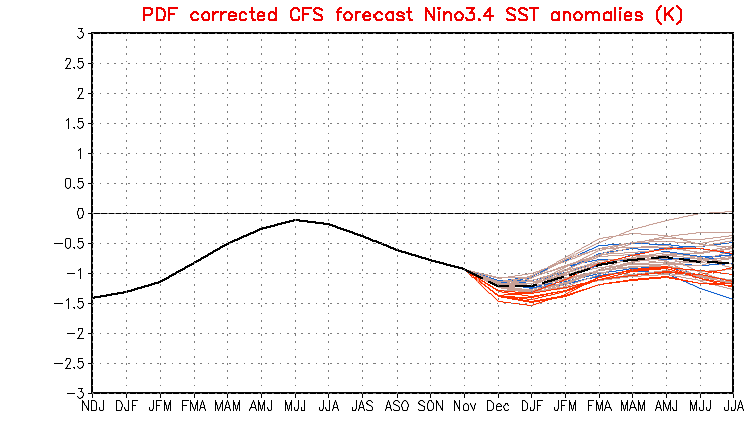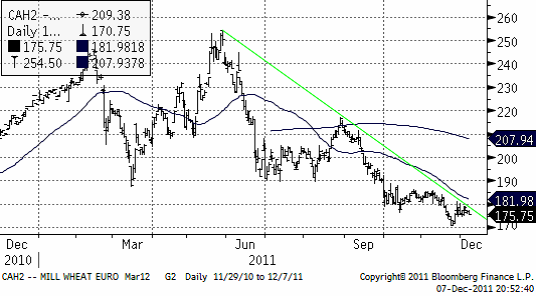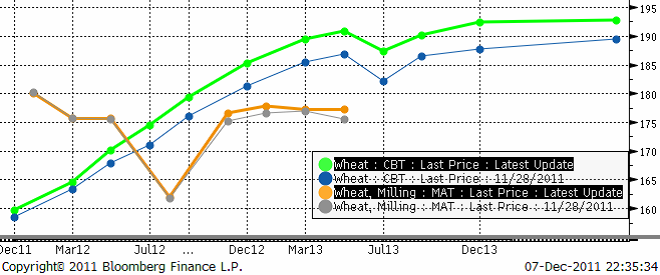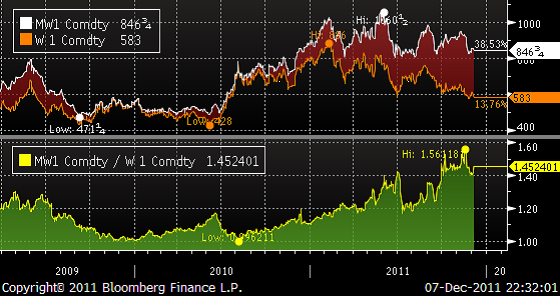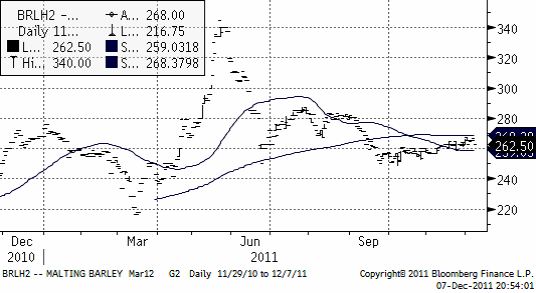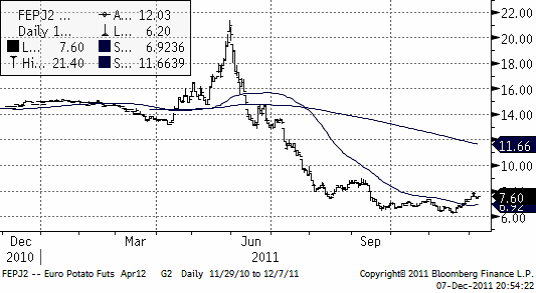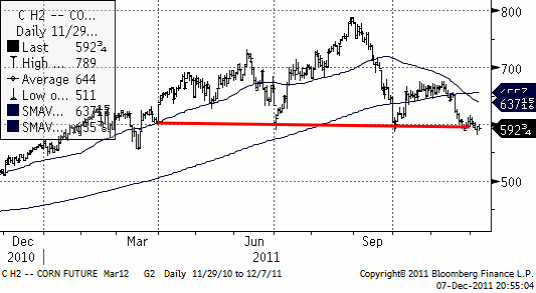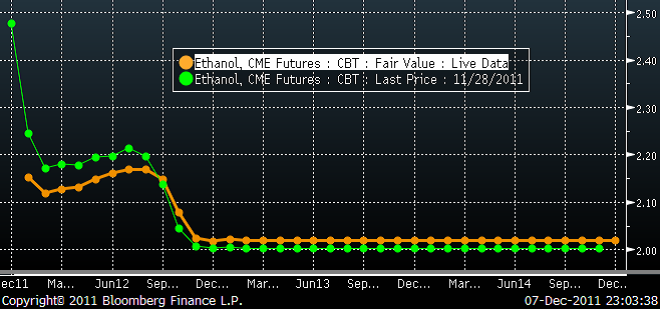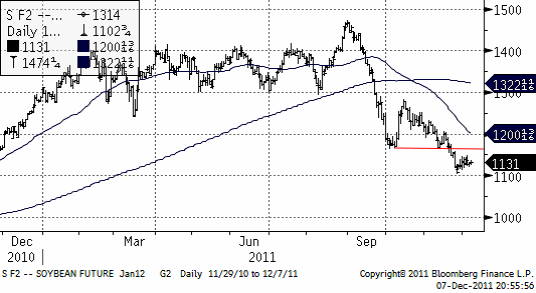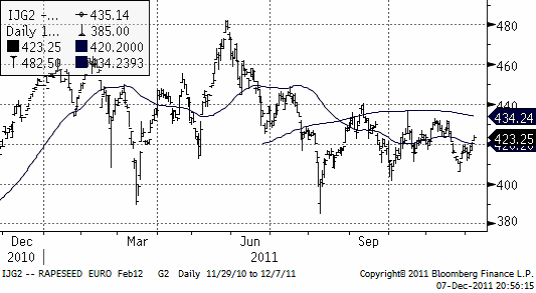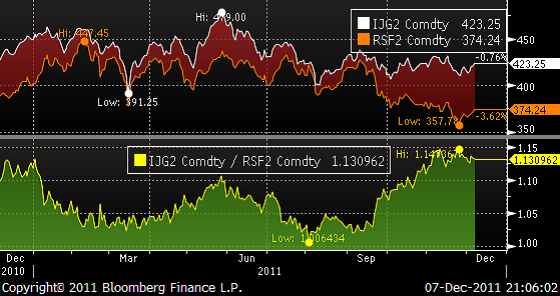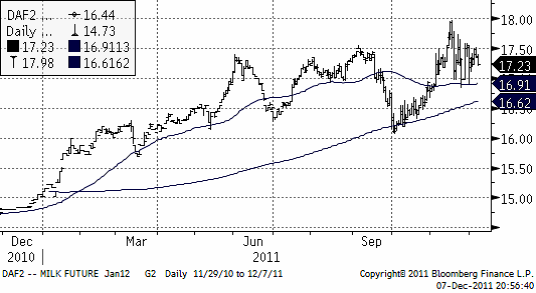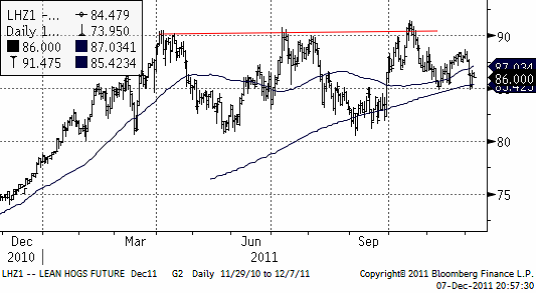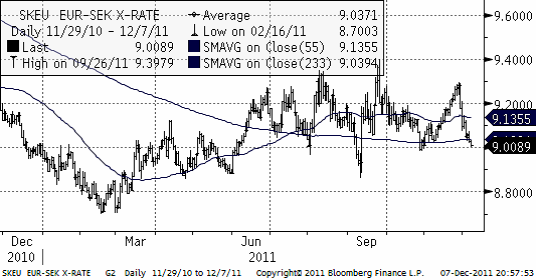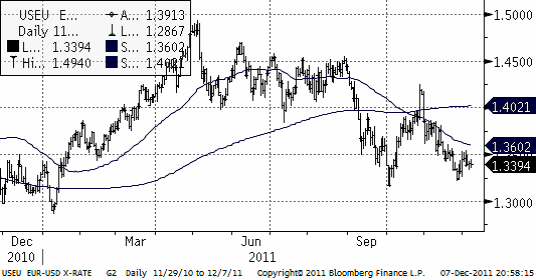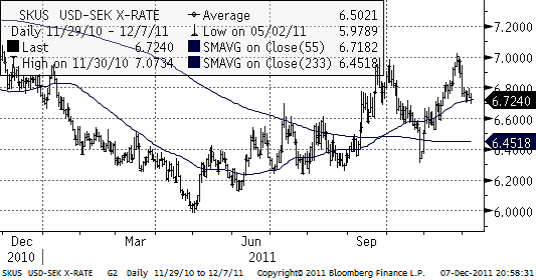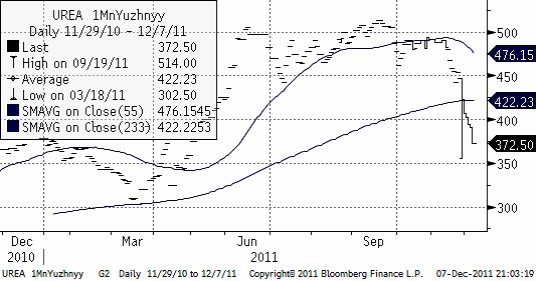Analys
SEB – Jordbruksprodukter, vecka 49
 Idag träffas EU-ledarna och besked väntas imorgon. Troligtvis blir det mer av pompa och mindre av en lösning, även om de alltså kommer att påstå det. Den politiska debatten är inriktad på sparande i statsbudgetarna i problemländerna. Problemet är dock ett klassiskt fall av för dålig konkurrenskraft för Spanien, Italien, Grekland, Portugal, delvis Frankrike, pga att lönerna och kostnaderna är för höga i förhållande eurons växelkurs för dessa länder i förhållande till andra länder.
Idag träffas EU-ledarna och besked väntas imorgon. Troligtvis blir det mer av pompa och mindre av en lösning, även om de alltså kommer att påstå det. Den politiska debatten är inriktad på sparande i statsbudgetarna i problemländerna. Problemet är dock ett klassiskt fall av för dålig konkurrenskraft för Spanien, Italien, Grekland, Portugal, delvis Frankrike, pga att lönerna och kostnaderna är för höga i förhållande eurons växelkurs för dessa länder i förhållande till andra länder.
Dessa länder borde antingen göra en ”intern devalvering”, som Estland gjorde, eller en devalvering som Sverige tvingades till 1992. Att fortsätta att ha kvar en fast växelkurs (euron) dödar ekonomin i dessa länder, som gör det än mer akut att devalvera (dvs lämna euron eller sänka lönerna). Hade Bengt Dennis fått hållas med 500% ränta i Sverige hade det inte funnits ett enda företag kvar 1992- 1993. Och konkursade företag återuppstår inte. Alltså, eftersom politikerna inte insett vad som är problemet och försöker ”spara” sig ur detta – alltså slå ut ekonomin ännu fortare, skyndar man bara på den totala kollapsen.
Till slut kommer inget alternativ återstå förutom att trycka pengar och inflatera bort skulderna, men än så länge kommer det bara att blir värre. Missförstå mig inte, inflation är ingen bra lösning, något av en katastrof för ekonomisk hälsa, men skulder måste betalas och det enklaste sättet är att trycka upp pengarna för det.
USDA:s WASDE-rapport imorgon är inte komplett och brukar inte ge någon effekt alls på marknaden.
Globalt väder
Nedan ser vi ensembleprognosen för La Niña från den 5 december och framåt. Ensembleprognosen är den streckade svarta linjen och den antyder att La Niña ska fortsätta att stärkas under våren 2012 och att den hänger kvar under sommaren.
Nedan ser vi markfuktigheten på 0 – 10 cm djup. Vi ser att det är torrt i Argentina och i södra Brasilien.
Vete
Terminspriset på Matif-vete (mars) har handlats i spannet 174.75 eur – 179.00 eur sedan förra veckan. Viss fundamenta har angett riktning för priset men marknaden påverkas också i nuläget av den oro som råder över den ekonomiska krisen i Europa. Aktiviteten har dock varit låg i avvaktan på fredagens WASDE rapport och utgången av EU-toppmötet.
 Det ukrainska jordbruksministeriet gick i fredags ut och meddelande att för nästa års veteskörd, 2012/13, så kommer produktionen endast att uppgå till 8.5 MT till skillnad mot 22.2 MT för 2011/12.
Det ukrainska jordbruksministeriet gick i fredags ut och meddelande att för nästa års veteskörd, 2012/13, så kommer produktionen endast att uppgå till 8.5 MT till skillnad mot 22.2 MT för 2011/12.
Man ska dock ta dessa uppgifter med en nypa salt då det fortfarande är tidigt att sia om nästa års skörd men OM de skulle stämma så skulle det vara vara ett stort bortfall för landet och det fick också terminspriserna att stiga ordentligt.
Sedan tog den ekonomiska oron över igen och terminspriserna föll tillbaka under måndag kväll efter att ratinginstitutet Standard & Poors beslutat att sätta 15 av de 17 euroländerna under bevakning med negativa utsikter.
Svartahavs-ländernas dominans på exportmarknaden av vete till Egypten bröts i tisdags då Argentina klev in på scenen och tog hem försäljningen av 180 000 ton (den första för den här säsongen).
Ryssland gick dock inte helt lottlösa i denna budgivning men bidrar med en ”mindre” del denna gång, 60 000 ton. Priserna på det europeiska vetet är fortfarande inte konkurrenskraftiga nog mot länderna ovan och Frankrike räknar med ett bortfall i sin export till Egypten på ca 90 % för 2011/12.
USA var inte med denna gång heller.
Vintertid brukar betyda logistikproblem för FSU-länderna. Kazakhstan hyrde in 5000 godsvagnar från Ryssland i ett försök att underlätta logistiken av sin rekordskörd, men har istället fått problem med åtkomsten till exporthamnar eftersom dessa ligger hos Ryssland och Ukraina som själva har fullt upp med att få ut sitt spannmål på marknaden. I väntan på att grannarna ska bli klara med sin export används godsvagnarna istället till lagring av spannmål.
Australien håller som bäst på att skörda det som som enligt ABARES förväntas bli en rekordsköd.
Även om regnet har ställt till det en del vad gäller kvalitén så finns det gott om köpare i Asien som ser fram emot att ersätta dyr majs med billigare vete från ”down under” till lägre kostnader och i försök att stävja de stigande matpriserna.
Även kanadensiska StatCan rapporterar om ökad veteproduktion för året med en uppgång på 9% eller 2.1 MT från 2010 och där framförallt durumvetet står för en stor del av ökningen.
Alexander Solovyev, vice jordbruksminister i Ryssland sade igår att den ryska exporten under marknadsföringsåret kan nå minst 25 mt. USDA väntar sig 19 mt enligt den senaste WASDErapporten.
Detta var alltså negativa nyheter för priset.
Solovyev menade också att exporten kan fördubblas de kommande 15 – 20 åren pga högre skörd per hektar och ökad areal. Allt tyder på att vetepriset ska ner.
Nedan ser vi terminskurvan för Chicagovete och Matif nu och för en vecka sedan. De ”feta” kurvorna är de aktuella. De ”smala” är förra veckans. Matif är nästan inte förändrat alls, medan priserna gått upp i Chicago – för längre löptider. Bakom ligger oro för kommande skörd pga La Niña kanske och förmodligen också för att räntorna (som man kan låna till) är högre.
Högproteinvete har blivit allt mer av en bristvara. Det vete som handlas på terminsbörser är det amerikanska vårvetet ”Red Spring” på Minneapolis Grain Exchange. Priset på det har dragit iväg i förhållande till ”kak-vetet” som handlas på Chicago Board of Trade. Nedan ser vi att spotkontraktet på MGX handlas 45% högre än CBOT:s.
Allt talar för att Matif-vete faller ner i första hand till 150 – 160 – euro-nivån.
Maltkorn
Maltkornsmarknaden följer vetet och det finns inga speciella nyheter att rapportera. Tekniskt ligger priset under glidande medelvärden. Den tekniska trenden är alltså nedåtriktad.
Potatis
Priset på potatis av årets skörd fortsatte stiga i veckan, ännu en vecka. Rapporten kom från Jordbruksverket tidigare i veckan om en betydligt högre skörd av matpotatis i Sverige, men informationen nådde alltså marknaden redan på försommaren, när priserna började falla.
Nedan ser vi kursdiagrammet på europeisk potatis, som handlas på Eurex; terminen avser leverans april nästa år.
Majs
Majspriset har hållit sig kvar vid stödet på 600 cent för mars-kontraktet. Väderleksrapporten för Argentina och södra Brasilien för de närmaste två veckorna innehåller väldigt lite regn och det gör, tillsammans med en oro för La Niña som verkar stärkas, att majsmarknaden fått stöd.
Kopplingen till etanol och oron kring Irans kärnvapenprogram och dess potentiellt explosiva effekt på oljepriset gör majshandlare oroliga att sälja, fast mycket annat tyder på att priset borde vara lägre.
Nedan ser vi marskontraktet på CBOT, där priset ligger på den nivå vid 600 cent där marknaden funnit stöd flera gånger. Den svagare dollarn gav ytterligare stöd för majspriset idag. Priset föll dock av ändå och stängde lågt.
Etanolmarginalen för amerikanska brännerier har säckat ihop och det beror på att etanolpriset handlas betydligt lägre för leverans nästa år jämfört med i år. Skatterabatten för att blanda etanol i bränsle försvinner, som bekant. Nedan ser vi terminspriserna framåt i tiden, där den nedre, lite kraftigare linjen är terminskurvan från onsdagskvällen (igår), medan den smalare är terminskurvan för 7 dagar sedan (den första av de terminerna har hunnit förfalla till idag).
Etanolefterfrågan har hållit majspriset uppe och nu ”borde” majspriset kunna falla under 600 cent / bu. WASDE imorgon fredag innehåller ingen statistik på produktion och marknadspåverkan blir därför väldigt liten. Decemberrapporterna brukar inte påverka marknaden.
Sojabönor
Priset på sojabönor befinner sig i en sjunkande trend. Priset har rekylerat upp lite den senaste veckan och det torde vara ett bra säljtillfälle.
Vi är negativa ur tekniskt perspektiv de närmaste tre månaderna.
Raps
Priset på raps har gått upp något sedan förra veckan och funnit stöd både från energimarknaden (råolja WTI som påverkas av det spända läget I Mellanöstern) och den vegetabiliska oljemarknaden (palmolja).
StatCan rapporterar att produktionen av raps (canola) slog nytt rekord under 2011 enligt deras sista prognos för året. Prognosen är 14.2 mt, en höjning sedan senast från 12.9 mt. Förra årets skörd var 12.8 mt.
ABARES i Australien höjde prognosen för rapsskörden med 200 kt. Nedan ser vi priset på februariterminen på Matif.
Matifraps är ovanligt dyrt i förhållande till canola i Kanada, som vi ser i nedanstående diagram. Ett premium på 13% är ovanligt högt.
Vi har en negativ vy på Matif raps.
Mjölk
Nedan ser vi priset på januarikontraktet på flytande mjölk (kontakt avräknat mot USDA:s prisindex). Priset har varit väldigt rörligt den senaste tiden. Trenden är uppåtriktad, men hög prisosäkerhet som vi ser nu, uppstår ibland i slutet av trender.
Gris
Tekniskt vilar priset på lean hogs på de glidande medelvärdena. Att priset ligger över gör att trenden är uppåtriktad. Det har inte kommit några nämnvärda nyheter sedan förra veckan. Tekniskt är bilden väldigt otydlig.
Valutor
EURSEK har handlats ner till den psykologiskt viktiga nivån 9 kr. Spänningen är stor inför fredagens EU-toppmöte.
EURUSD är i en tydlig negativ trend.
USDSEK har en stigande trend. Just nu vilar priset på 55-dagars glidande medelvärde, och det ger stöd (många tittar på den tekniska indikatorn).
Gödsel
Kväve
Nedan ser vi 1 månads terminspris på Urea fob Uyzhnyy. Priset har fallit kraftigt under hösten.
[box]SEB Veckobrev Jordbruksprodukter är producerat av SEB Merchant Banking och publiceras i samarbete och med tillstånd på Råvarumarknaden.se[/box]
Disclaimer
The information in this document has been compiled by SEB Merchant Banking, a division within Skandinaviska Enskilda Banken AB (publ) (“SEB”).
Opinions contained in this report represent the bank’s present opinion only and are subject to change without notice. All information contained in this report has been compiled in good faith from sources believed to be reliable. However, no representation or warranty, expressed or implied, is made with respect to the completeness or accuracy of its contents and the information is not to be relied upon as authoritative. Anyone considering taking actions based upon the content of this document is urged to base his or her investment decisions upon such investigations as he or she deems necessary. This document is being provided as information only, and no specific actions are being solicited as a result of it; to the extent permitted by law, no liability whatsoever is accepted for any direct or consequential loss arising from use of this document or its contents.
About SEB
SEB is a public company incorporated in Stockholm, Sweden, with limited liability. It is a participant at major Nordic and other European Regulated Markets and Multilateral Trading Facilities (as well as some non-European equivalent markets) for trading in financial instruments, such as markets operated by NASDAQ OMX, NYSE Euronext, London Stock Exchange, Deutsche Börse, Swiss Exchanges, Turquoise and Chi-X. SEB is authorized and regulated by Finansinspektionen in Sweden; it is authorized and subject to limited regulation by the Financial Services Authority for the conduct of designated investment business in the UK, and is subject to the provisions of relevant regulators in all other jurisdictions where SEB conducts operations. SEB Merchant Banking. All rights reserved.
Analys
Tightening fundamentals – bullish inventories from DOE

The latest weekly report from the US DOE showed a substantial drawdown across key petroleum categories, adding more upside potential to the fundamental picture.

Commercial crude inventories (excl. SPR) fell by 5.8 million barrels, bringing total inventories down to 415.1 million barrels. Now sitting 11% below the five-year seasonal norm and placed in the lowest 2015-2022 range (see picture below).
Product inventories also tightened further last week. Gasoline inventories declined by 2.1 million barrels, with reductions seen in both finished gasoline and blending components. Current gasoline levels are about 3% below the five-year average for this time of year.
Among products, the most notable move came in diesel, where inventories dropped by almost 4.1 million barrels, deepening the deficit to around 20% below seasonal norms – continuing to underscore the persistent supply tightness in diesel markets.
The only area of inventory growth was in propane/propylene, which posted a significant 5.1-million-barrel build and now stands 9% above the five-year average.
Total commercial petroleum inventories (crude plus refined products) declined by 4.2 million barrels on the week, reinforcing the overall tightening of US crude and products.


Analys
Bombs to ”ceasefire” in hours – Brent below $70

A classic case of “buy the rumor, sell the news” played out in oil markets, as Brent crude has dropped sharply – down nearly USD 10 per barrel since yesterday evening – following Iran’s retaliatory strike on a U.S. air base in Qatar. The immediate reaction was: “That was it?” The strike followed a carefully calibrated, non-escalatory playbook, avoiding direct threats to energy infrastructure or disruption of shipping through the Strait of Hormuz – thus calming worst-case fears.

After Monday morning’s sharp spike to USD 81.4 per barrel, triggered by the U.S. bombing of Iranian nuclear facilities, oil prices drifted sideways in anticipation of a potential Iranian response. That response came with advance warning and caused limited physical damage. Early this morning, both the U.S. President and Iranian state media announced a ceasefire, effectively placing a lid on the immediate conflict risk – at least for now.
As a result, Brent crude has now fallen by a total of USD 12 from Monday’s peak, currently trading around USD 69 per barrel.
Looking beyond geopolitics, the market will now shift its focus to the upcoming OPEC+ meeting in early July. Saudi Arabia’s decision to increase output earlier this year – despite falling prices – has drawn renewed attention considering recent developments. Some suggest this was a response to U.S. pressure to offset potential Iranian supply losses.
However, consensus is that the move was driven more by internal OPEC+ dynamics. After years of curbing production to support prices, Riyadh had grown frustrated with quota-busting by several members (notably Kazakhstan). With Saudi Arabia cutting up to 2 million barrels per day – roughly 2% of global supply – returns were diminishing, and the risk of losing market share was rising. The production increase is widely seen as an effort to reassert leadership and restore discipline within the group.
That said, the FT recently stated that, the Saudis remain wary of past missteps. In 2018, Riyadh ramped up output at Trump’s request ahead of Iran sanctions, only to see prices collapse when the U.S. granted broad waivers – triggering oversupply. Officials have reportedly made it clear they don’t intend to repeat that mistake.
The recent visit by President Trump to Saudi Arabia, which included agreements on AI, defense, and nuclear cooperation, suggests a broader strategic alignment. This has fueled speculation about a quiet “pump-for-politics” deal behind recent production moves.
Looking ahead, oil prices have now retraced the entire rally sparked by the June 13 Israel–Iran escalation. This retreat provides more political and policy space for both the U.S. and Saudi Arabia. Specifically, it makes it easier for Riyadh to scale back its three recent production hikes of 411,000 barrels each, potentially returning to more moderate increases of 137,000 barrels for August and September.
In short: with no major loss of Iranian supply to the market, OPEC+ – led by Saudi Arabia – no longer needs to compensate for a disruption that hasn’t materialized, especially not to please the U.S. at the cost of its own market strategy. As the Saudis themselves have signaled, they are unlikely to repeat previous mistakes.
Conclusion: With Brent now in the high USD 60s, buying oil looks fundamentally justified. The geopolitical premium has deflated, but tensions between Israel and Iran remain unresolved – and the risk of missteps and renewed escalation still lingers. In fact, even this morning, reports have emerged of renewed missile fire despite the declared “truce.” The path forward may be calmer – but it is far from stable.
Analys
A muted price reaction. Market looks relaxed, but it is still on edge waiting for what Iran will do

Brent crossed the 80-line this morning but quickly fell back assigning limited probability for Iran choosing to close the Strait of Hormuz. Brent traded in a range of USD 70.56 – 79.04/b last week as the market fluctuated between ”Iran wants a deal” and ”US is about to attack Iran”. At the end of the week though, Donald Trump managed to convince markets (and probably also Iran) that he would make a decision within two weeks. I.e. no imminent attack. Previously when when he has talked about ”making a decision within two weeks” he has often ended up doing nothing in the end. The oil market relaxed as a result and the week ended at USD 77.01/b which is just USD 6/b above the year to date average of USD 71/b.

Brent jumped to USD 81.4/b this morning, the highest since mid-January, but then quickly fell back to a current price of USD 78.2/b which is only up 1.5% versus the close on Friday. As such the market is pricing a fairly low probability that Iran will actually close the Strait of Hormuz. Probably because it will hurt Iranian oil exports as well as the global oil market.
It was however all smoke and mirrors. Deception. The US attacked Iran on Saturday. The attack involved 125 warplanes, submarines and surface warships and 14 bunker buster bombs were dropped on Iranian nuclear sites including Fordow, Natanz and Isfahan. In response the Iranian Parliament voted in support of closing the Strait of Hormuz where some 17 mb of crude and products is transported to the global market every day plus significant volumes of LNG. This is however merely an advise to the Supreme leader Ayatollah Ali Khamenei and the Supreme National Security Council which sits with the final and actual decision.
No supply of oil is lost yet. It is about the risk of Iran closing the Strait of Hormuz or not. So far not a single drop of oil supply has been lost to the global market. The price at the moment is all about the assessed risk of loss of supply. Will Iran choose to choke of the Strait of Hormuz or not? That is the big question. It would be painful for US consumers, for Donald Trump’s voter base, for the global economy but also for Iran and its population which relies on oil exports and income from selling oil out of that Strait as well. As such it is not a no-brainer choice for Iran to close the Strait for oil exports. And looking at the il price this morning it is clear that the oil market doesn’t assign a very high probability of it happening. It is however probably well within the capability of Iran to close the Strait off with rockets, mines, air-drones and possibly sea-drones. Just look at how Ukraine has been able to control and damage the Russian Black Sea fleet.
What to do about the highly enriched uranium which has gone missing? While the US and Israel can celebrate their destruction of Iranian nuclear facilities they are also scratching their heads over what to do with the lost Iranian nuclear material. Iran had 408 kg of highly enriched uranium (IAEA). Almost weapons grade. Enough for some 10 nuclear warheads. It seems to have been transported out of Fordow before the attack this weekend.
The market is still on edge. USD 80-something/b seems sensible while we wait. The oil market reaction to this weekend’s events is very muted so far. The market is still on edge awaiting what Iran will do. Because Iran will do something. But what and when? An oil price of 80-something seems like a sensible level until something do happen.
-

 Nyheter4 veckor sedan
Nyheter4 veckor sedanStor uppsida i Lappland Guldprospekterings aktie enligt analys
-

 Nyheter4 veckor sedan
Nyheter4 veckor sedanSilverpriset släpar efter guldets utveckling, har mer uppsida
-

 Nyheter3 veckor sedan
Nyheter3 veckor sedanUppgången i oljepriset planade ut under helgen
-

 Nyheter3 veckor sedan
Nyheter3 veckor sedanLåga elpriser i sommar – men mellersta Sverige får en ökning
-

 Nyheter2 veckor sedan
Nyheter2 veckor sedanMahvie Minerals växlar spår – satsar fullt ut på guld
-

 Analys3 veckor sedan
Analys3 veckor sedanVery relaxed at USD 75/b. Risk barometer will likely fluctuate to higher levels with Brent into the 80ies or higher coming 2-3 weeks
-

 Nyheter1 vecka sedan
Nyheter1 vecka sedanOljan, guldet och marknadens oroande tystnad
-

 Nyheter1 vecka sedan
Nyheter1 vecka sedanJonas Lindvall är tillbaka med ett nytt oljebolag, Perthro, som ska börsnoteras


